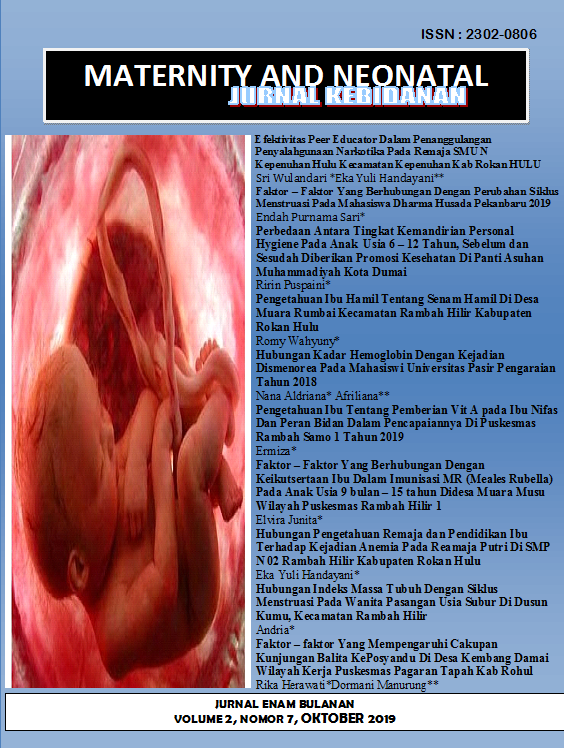EFEKTIFITAS PEER EDUCATOR DALAM PENANGGULANGAN PENYALAHGUNAAN NARKOTIKA PADA REMAJA SMU N KEPENUHAN HULU KECAMATAN KEPENUHAN KABUPATEN ROKAN HULU.
Keywords:
peer educator teenagers, drugs abuseAbstract
Drug abuse and distribution dark was a serious problem alarming international.The unodc, indonesia currently in the first place in the number of suspected drug. aseanThe survey by the agency years 2017 total penyalahguna 3.376.115, the narcotic and prevalence of highest is in the educated middle class. this is concernedThe united nations officion on drugs and crime ( unodc ) stated that 27 0,6 million people or percent of the population age this year is 15-64. suffers with consumption of drugs Drug abuse endangers life penyalahguna, and others drugs abuse, negatively impact on the physical psychological, social and spiritual so this had an impact on the outcome. learning achievementsThe impact is slow work, careless, work lost confidence, apathetic, pengkhayal, be vicious and brutal behavior. Difficult to concentrate, tend to hurt themselves. even suicideFormer needed.The purpose of this research is to find the effectiveness of peer educator conducted by former users and nonusers narcotic drugs abuse prevention of juvenile smun 1 fullness. upstreamThe study used is quasi experiment is pretest-postes comparison with, group for the purpose of knowing the difference the effectiveness of peer educator conducted by former drugs users and not using drugs abuse prevention of juvenile smun 1 fullness. upstreamWith the total sample 80, one the group 40 information given by former users of narcotics and 40 one group who were given information by not using. narcotics To be performed by steps:1.The preparatory stage ( making ) module.2.The election3. peer educatorPhase of the Topicresearch objectives made a pact and exercise peer educator, and evaluate the training and the rest of the data collection will intervene in teenagers peer educator education health by former drug users and nonusers.The outer covering of the research is a scholarly article was published in the national and not accredited issn ( maternity and neonatal and issn 2302-0806 ), article was published in national, proceeding research will be presented (Keynote Speaker /Invited) invited the keynote speaker at a national scientific.The readiness of technology ( TKT ) the formulation of the concept is applying the knowledge and development of the community in berprilaku healthy to empower society itself especially the youth prevention as drugs abuse by the provision of information and genuine true keywordsReferences
Asmadi. (2017). Efektifitas Model Peer Educator Mantan Pengguna dan bukan Pengguna Narkoba terhadap Pencegahan Penyalahgunaan Narkoba Pada Remaja di Kabupaten Kuningan. Prosiding Hefa 1st 2017.
Badan Narkotika Nasional RI, (2011). Pelayanan Rehabilitasi Terpadu bagi Korban Penyalahgunaan Narkoba. Jakarta: Direktorat Pelayanan dan Rehabilitasi
BNN, (2012). Ringkasan Eksekutif, Survei Nasional Perkembangan Penyalahgunaan dan Peredaran Gelap Narkoba pada Kelompok Pelajar/Mahasiswa di Indonesia Tahun 2011. Jakarta:
BNN, (2015). Laporan Akhir Survei Nasional Perkembangan Penyalahguna Narkoba Tahun Anggaran 2014. Jakarta: BNN.
BNN, (2017). Survei Nasional Penyalahgunaan Narkoba Di 34 Provinsi. Jakarta: BNN.
Hidayati, P.E., dkk., 2012. Gambaran Pengetahuan dan Upaya Pencegahan terhadap Penyalahgunaan Narkoba pada Remaja di SMK Negeri 2 Sragen. Jurnal Gaster, Vol.9 No.1 Februari 2012.
Handayani, S. 2011. Pengaruh Keluarga, Masyarakat dan Pendidikan terhadap Pencegahan Bahaya Narkoba di Kalangan Remaja. Tesis Diterbitkan. Jakarta: Pascasarjana Program Studi Pengkajian Ketahanan Nasional UI.
Imron, A. (2014). Pendidikan Kesehatan Reproduksi Remaja. Yogyakarta: Ar-Ruzz Media.
Lestari, I., dkk. 2014. Hubungan Pengetahuan, Sikap Siswa dan Pekerjaan Orangtua tentang Narkoba pada Siswa SMA Negeri 1 Takalar. Jurnal Ilmiah Kesehatan Diagnosis, Vol. 5 No. 2 Tahun 2014.
Lestary, H., dkk., 2011. Perilaku Berisiko Remaja di Indonesia menurut Survey Kesehatan Reproduksi Remaja di Indonesia (SKRRI) Tahun 2007. Jurnal Kesehatan Reproduksi, Vol. 1 No. 3. Agustus 2011: 136144.
Muslihatun, dkk (2015). Antisipasi Remaja Terhadap Bahaya Penyalahgunaan Narkoba Dalam Triad Kesehatan Reproduksi Remaja Di Sleman. Jurnal Kebidanan dan Keperawatan, Vol. 11, No. 1.
Notoadmodjo, S. (2010). Metodologi Penelitian Kesehatan. Jakarta : Rineka Cipta
Purnomo K. I, dkk (2012). Perbandingan pengaruh metode pendidikan sebaya dan metode ceramah terhadap pengetahuandan sikap pengendalian HIV/AIDS pada mahasiswa fakultas olahraga dan kesehatan Universitas Pendidikan Ganesha (Jurnal Magister Kedokteran Keluarga Vol 1 No. 1 Thn 2013)
Purnomo , K. I, Murti, B dan Suriyasa, P. (2013). Perbandingan pengaruh metode pendidikan sebaya dan metode ceramah terhadap pengetahuan dan sikap pengendalian HIV/AIDS pada mahasiswa fakultas olahraga dan kesehatan unversitas pendidikan ganesha. Jurnal Magister Kedokteran Keluarga, Vol 1, No 1, Hal 49-56.
Prosiding Health Events For All, (2017). Publikasi Riset Kesehatan untuk Daya Saing Bangsa, ISSN 2581 – 2270. Lembaga Penelitian dan Pengabdian Masyarakat Sekolah Tinggi Ilmu Kesehatan Cendekia Utama Kudus.
Suryani, dkk, (2014). “Upaya Pencegahan Penyalahgunaan Narkoba Dan Seks Bebas Serta Peningkatan Kemampuan Koping Remaja Berbasis Kelompok Sebaya Di Smp Dan Sma Di Jatinangor” Dharmakarya: Jurnal
Aplikasi Ipteks untuk Masyarakat Vol. 3, No. 2 ISSN 1410 – 5675.
United Nations Office on Drugs and Crime (UNODC), (2015). World Drug Report 2014, United Nations, New York.
Vingilis, E., Wade, T. & Seeley, J. (2007) Predictors of adolescent health care utilization. J Adolesc Health, 30(5): 773-800.
Yuli Ardiansyah dan Lalu Abdurrahman (2013). “Penyuluhan Pencegahan Bahaya Narkoba terhadap Anak-anak Usia Dini” Jurnal Inovasi dan Kewirausahaan, Volume 2 Nomor II
Zimmer-Gembeck, M. J. (2002) The development of romantic relationships and adaptations in the system of peer relationships. Journal of Adolescent Health, 31(6).


